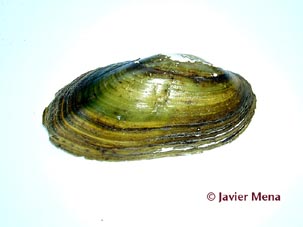The name "bivalve" refers to the two-part shell that characterizes these mollusc species. The two valves of the shell are joined by a ligamentous hinge and held shut by a pair of strong adductor muscles.
Bivalves are exclusively aquatic; they include both marine and freshwater forms. Includes marine clams, oysters, mussels and scallops and freshwater mussels and they can be sessile or sedentary.
Bivalves are filter-feeders which extract organic matter from the water in which they live.
Around 20,000 known species.
The shells made of calcium carbonate can display different forms
Shells of bivalves
TO EXTEND IMAGE

Cockle
TO EXTEND IMAGE
Many species burrow in the sand or mud. Mussels attach to rocks by means of a beard-like byssus, while oysters cement one of their valves to the rock face.
Powerful anterior & posterior adductor muscles open & close shell
Bivalves have separate sexes with external fertilization of eggs

Mussel with a beard-like byssus


